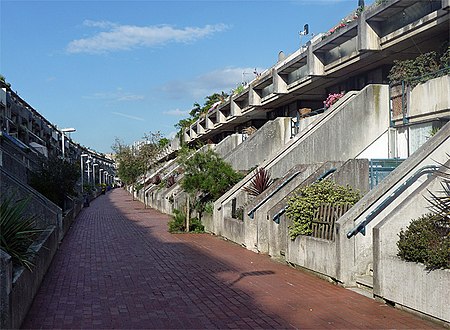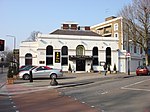Alexandra Road Estate
1978 establishments in EnglandBrutalist architecture in LondonGrade II* listed buildings in the London Borough of CamdenHousing estates in the London Borough of CamdenUse British English from March 2014 ... and 1 more
Ziggurat style modern architecture

The Alexandra Road estate (officially the Alexandra and Ainsworth estate, but often referred to as Rowley Way, the name of its main thoroughfare) is a housing estate in the London Borough of Camden, North West London, England. It was designed in a brutalist style in 1968 by Neave Brown of Camden Council's Architects Department. Construction work commenced in 1972 and was completed in 1978. It is constructed from site-cast, board-marked white, unpainted reinforced concrete. Along with 520 apartments, the site also includes a school, community centre, youth club, heating complex, and parkland.
Excerpt from the Wikipedia article Alexandra Road Estate (License: CC BY-SA 3.0, Authors, Images).Alexandra Road Estate
Ainsworth Way, London South Hampstead (London Borough of Camden)
Geographical coordinates (GPS) Address Nearby Places Show on map
Geographical coordinates (GPS)
| Latitude | Longitude |
|---|---|
| N 51.539167 ° | E -0.183333 ° |
Address
Ainsworth Way
NW8 0HR London, South Hampstead (London Borough of Camden)
England, United Kingdom
Open on Google Maps










